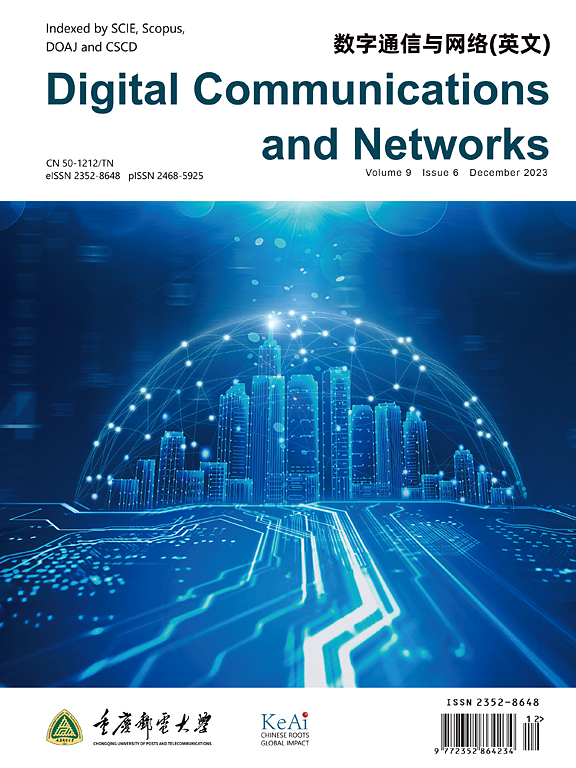支持MU-MIMO的LTE-U网络与D2D和WiFi网络共存的性能分析
IF 7.5
2区 计算机科学
Q1 TELECOMMUNICATIONS
引用次数: 0
摘要
LTE-Unlicensed (LTE-U) 网络是一种使用非授权频谱的蜂窝通信网络。将蜂窝流量卸载到 WiFi 或设备到设备(D2D)网络会导致它们之间的干扰。在蜂窝基站(CBS)和 WiFi 接入点(WAP)中应用多输入多输出(MIMO)技术可有效减少 D2D、WiFi 和蜂窝网络之间的干扰。据我们所知,目前还没有文献明确研究多用户 MIMO(MU-MIMO)网络与 D2D 和 WiFi 网络共存时的流量卸载特性。在本文中,我们深入研究了 D2D 通信以及支持 MU-MIMO 的 WAP 和 CBS 对 LTE-U 网络性能的影响。更具体地说,我们推导了蜂窝用户、D2D 用户和 WiFi 用户在不完整信道状态信息(CSI)反馈下的下行链路速率表达式,并通过蒙特卡洛仿真验证了我们的分析。大量结果说明了以下结论。(i) 增加 WiFi 用户数量、CSI 反馈长度以及与单个蜂窝用户重用信道的 D2D 对数量,可提高异构网络的总吞吐量。(ii) 当超过两个用户被卸载到 D2D 对时,总吞吐量会下降;当少于六个用户被卸载到 WiFi 网络时,总吞吐量会随着卸载用户数量的增加而增加。(iii) 同时向 D2D 对和 WiFi 网络卸载流量比只向其中一个网络卸载流量能获得更高的总吞吐量。本文章由计算机程序翻译,如有差异,请以英文原文为准。
Performance analysis for MU-MIMO enabled LTE-U networks coexisting with D2D and WiFi network
LTE-Unlicensed (LTE-U) network is a type of cellular communication network operating the unlicensed spectrum. Offloading cellular traffic to WiFi or Device-to-Device (D2D) network can lead to interference among them. Applying Multiple-Input Multiple-Output (MIMO) technology in Cellular Base Station (CBS) and WiFi Access Point (WAP) can effectively reduce interference among D2D, WiFi and cellular networks. To our best knowledge, there is still no literature to explicitly study the characteristics of the traffic offloading in the Multiple-User MIMO (MU-MIMO) enabled network coexisting with D2D and WiFi networks. In this article, we thoroughly investigate the impact of D2D communication and MU-MIMO enabled WAP and CBS on the performance of the LTE-U network. More specifically, we derive the expressions of the downlink rates for cellular users, D2D users, and WiFi users with incomplete Channel State Information (CSI) feedback, and we validate our analysis through Monte-Carlo simulation. Numerous results illustrate the following conclusions. (i) Increasing the number of WiFi users, the length of CSI feedback, and the quantity of D2D pairs that reuse the channel with a single cellular user can increase the total throughput of the heterogeneous network. (ii) The total throughput decreases when more than two users are offloaded to D2D pairs, and increases as the number of offloaded users increases when less than six users are offloaded to WiFi network. (iii) Simultaneously offloading traffic to D2D pairs and WiFi network can obtain higher total throughput than offloading traffic to only one of them.
求助全文
通过发布文献求助,成功后即可免费获取论文全文。
去求助
来源期刊

Digital Communications and Networks
Computer Science-Hardware and Architecture
CiteScore
12.80
自引率
5.10%
发文量
915
审稿时长
30 weeks
期刊介绍:
Digital Communications and Networks is a prestigious journal that emphasizes on communication systems and networks. We publish only top-notch original articles and authoritative reviews, which undergo rigorous peer-review. We are proud to announce that all our articles are fully Open Access and can be accessed on ScienceDirect. Our journal is recognized and indexed by eminent databases such as the Science Citation Index Expanded (SCIE) and Scopus.
In addition to regular articles, we may also consider exceptional conference papers that have been significantly expanded. Furthermore, we periodically release special issues that focus on specific aspects of the field.
In conclusion, Digital Communications and Networks is a leading journal that guarantees exceptional quality and accessibility for researchers and scholars in the field of communication systems and networks.
 求助内容:
求助内容: 应助结果提醒方式:
应助结果提醒方式:


